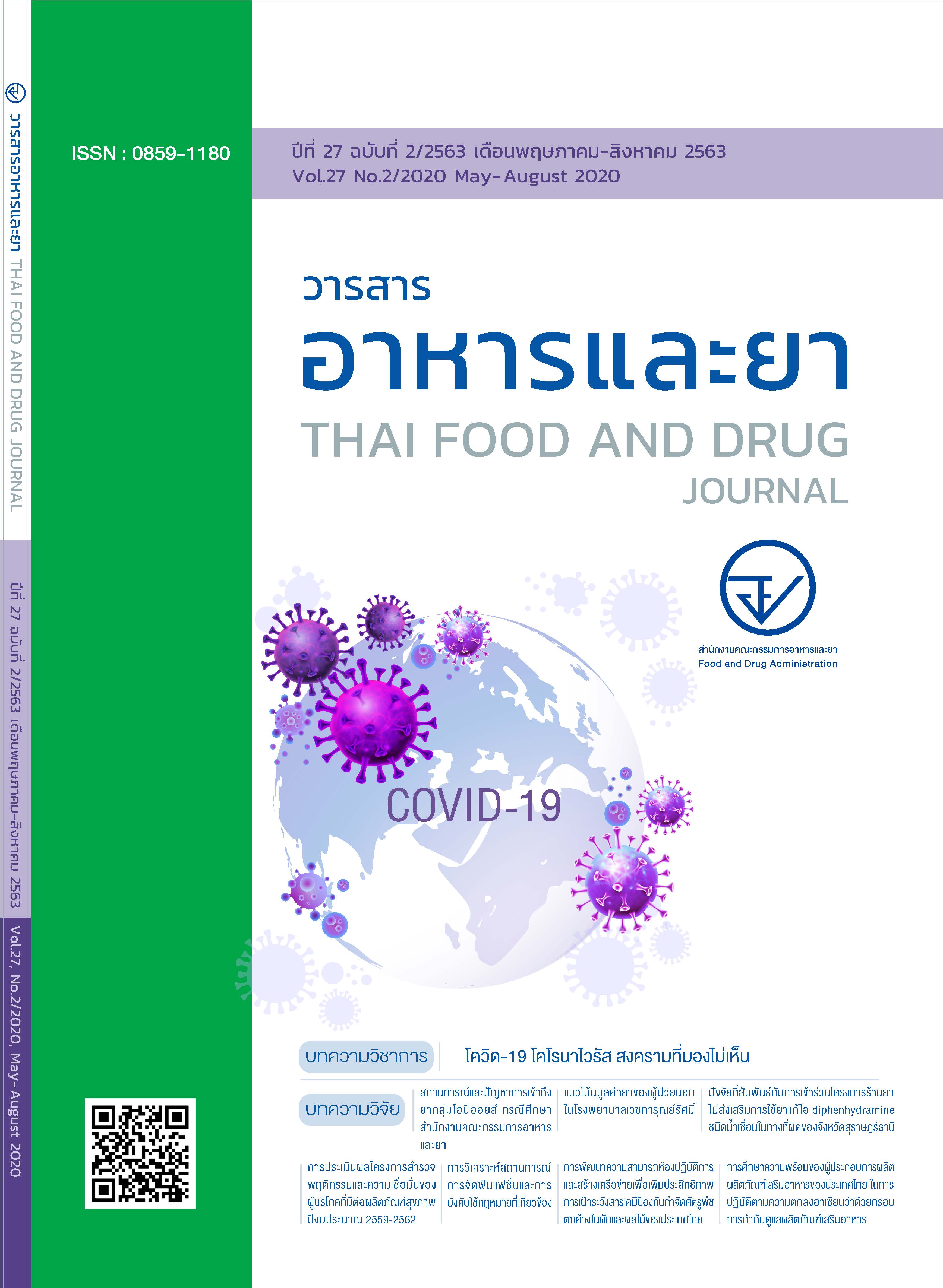สถานการณ์และปัญหาการเข้าถึงยากลุ่มโอปิออยส์ กรณีศึกษา สำนักงานคณะกรรมการอาหารและยา
Main Article Content
บทคัดย่อ
การศึกษานี้เป็นแบบภาคตัดขวาง มีวัตถุประสงค์เพื่อศึกษา (1) สถานการณ์การใช้ยากลุ่มโอปิออยส์ใน
ประเทศไทยในช่วง 7 ปี (ระหว่างปี 2555-2561) (2) ปัญหาการเข้าถึงยากลุ่มโอปิออยส์ของผู้ป่วยในประเทศไทย
และ (3) ขอ้ เสนอแนะการบริหารจัดการยากลุ่มโอปอิ อยสเ์ พื่อเพิ่มการเขา้ ถึงยาในสถานพยาบาล เก็บขอ้ มูลจากฐาน
ข้อมูลปริมาณการขายยากลุ่มโอปิออยส์ และใช้แบบสอบถามบุคลากรทางการแพทย์ในสถานพยาบาลทั่วประเทศ
ที่มีใบอนุญาตจำหน่ายยาเสพติดให้โทษประเภท 2 และซื้อยากลุ่มโอปิออยส์ ผลการศึกษาสถานการณ์แนวโน้ม
ปริมาณการใชย้ ากลุ่มโอปอิ อยสใ์ นชว่ ง 7 ป ี พบวา่ ยาโคเดอีน เมทาโดน มอรฟ์ นี เพทิดีน เฟนทานิล และออกซิโคโดน
มีปริมาณการใช้ยากลุ่มโอปิออยส์ต่อโควตาที่ได้รับการจัดสรรที่ดีที่สุดคือในปี 2561 อย่างไรก็ตาม คิดเป็นเพียง
รอ้ ยละ 52.7 เทา่ นั้น ซึ่งคา่ นี้จะแสดงถึงการเขา้ ถึงและระบบการจัดการที่ดีของยากลุ่มนี้ การกระจายการใชโ้ คเดอีน
และมอร์ฟีนในโรงพยาบาลของรัฐประมาณร้อยละ 90 สำหรับหน่วยที่ใช้มากสุด ได้แก่ หน่วยการรักษาแบบประคับ
ประคองร้อยละ 55.6 หน่วยวิสัญญี หน่วยระงับปวด และหน่วยบำบัดยาเสพติด ร้อยละ 38.0 32.8 และ 10.5
ตามลำดับ ซึ่งการเข้าถึงยาแต่ละชนิดพบว่า morphine oral, morphine injection และ pethidine injection
เข้าถึงได้ในระดับมาก ในขณะที่ fentanyl injection, fentanyl TTS (Transdermal Therapeutic System)
และ codeine เข้าถึงได้ปานกลาง ส่วน methadone และ oxycodone เข้าถึงได้น้อย ซึ่ง 5 ปัญหาสำคัญได้แก่
(1) การไม่รับแลกเปลี่ยนหรือคืนยาหมดอายุ (2) ข้อจำกัดในการแลกเปลี่ยนยาระหว่างโรงพยาบาลกรณียาใกล้หมด
อายุหรือใช้ไม่ทัน (3) ข้อจำกัดในการยืมยาระหว่างโรงพยาบาลกรณีขาดยาฉุกเฉิน (4) การมีการปรับลดปริมาณ
14 THAI FOOD AND DRUG JOURNAL : MAY-AUGUST 2020
อนุมัติขายกรณียาขาดชั่วคราว และ (5) กฎระเบียบที่ยุ่งยากและเปน็ ภาระในการทำลายยาหมดอายุของสถานพยาบาล
สว่ นขอ้ เสนอสำคัญของการบริหารจัดการยาที่กลุ่มตัวอย่างแสดงความคิดเห็นไดแ้ ก ่ การเพิ่มเนื้อหาการเรียนการสอน
เกี่ยวกับการใช้ยากลุ่มโอปิออยส์และกฎหมาย การแก้ไขกฎหมายให้มีการยืมยาระหว่างสถานพยาบาลภาครัฐ
จัดอบรม จัดทำสื่อสร้างทัศนคติเชิงบวกและความรู้ความเข้าใจการใช้ยาอย่างถูกต้อง และจัดทำศูนย์ข้อมูลกลาง
รองรับการแจ้งปริมาณยาใกล้หมดอายุ ดังนั้นจึงมีข้อเสนอแนะ ได้แก่ การปรับปรุงกฎหมายและระเบียบวิธีปฏิบัติ
รวมทั้งการปรับระบบการทำงานและลดขั้นตอนการให้บริการโดยใช้เทคโนโลยีสารสนเทศ สร้างระบบ Node ยา
และเครือข่ายเภสัชกรในแต่ละจังหวัด รวมทั้งให้ อย. เป็นศูนย์กลางในการประสานงานเครือข่ายและเจ้าภาพในการ
จัดอบรมความรู้แก่บุคลากรทางการแพทย์
Article Details
เอกสารอ้างอิง
primates. Science Translational Medicine. [Internet]. 2018 [cited 2020 Feb 15]: 1-11. Available from https://stm.science mag. org/content/10/456/eaar3483?TB_iframe =true&width=921.6&height=921.6
2. กองควบคุมวัตถุเสพติด. รวมกฎหมายยาเสพติดให้โทษ. ออกตามความในพระราชบัญญัติยาเสพติดให้โทษ พ.ศ. 2522 และฉบับแก้ไขเพิ่มเติม. สำนักงาน
คณะกรรมการอาหารและยา. กรุงเทพฯ : สำนักงานพระพุทธศาสนาแห่งชาติ; 2547.
3. World Health Organization. Cancer. [Internet] [cited 2019 Aug 10]. Available from http: www.who.int/cancer/palliative/definition/en
4. กองบริหารการสาธารณสุข สำนักงานปลัดกระทรวงสาธารณสุข แนวทางการบริหารจัดการระบบยาในการดูแลผู้ป่วยแบบประคับประคอง (PalliativeCare).[อินเทอร์เน็ต] .2561. [เข้าถึงเมื่อ 16 ธ.ค.2562]. เข้าถึงได้จาก http://phdb.moph.go.th/main/index/detail/30110
5. Berterame S, et al. Use of and barriers to access to opioid analgesics: a worldwide,regional, and national study. The Lancet;2016.1644-56. doi: 10.1016/S0140-6736(16)00161-6. PubMed PMID: 26852264.
6. ทองหลอ่ เดชไทย. ภาวะผู้นำ: เพื่อการบริหารคุณภาพสู่ความเป็นเลิศ กรุงเทพฯ: คณะสาธารณสุขศาสตร์มหาวิทยาลัยมหิดล; 2545.
7. กระทรวงสาธารณสุข. ประกาศกระทรวงสาธารณสุข เรื่อง กำหนดชนิดและจำนวนยาเสพติดให้โทษในประเภท 2 ที่จะต้องใช้ในทางการแพทย์และทางวิท ยาศาสตร์ทั่วราชอาณาจกั รประจำป ี พ.ศ.2555. ราชกิจจานุเบกษา เล่มที่ 129, ตอนพิเศษ 22 ง (ลงวันที่ 24 มกราคม 2555).
8. กระทรวงสาธารณสุข. ประกาศกระทรวงสาธารณสุข เรื่อง กำหนดชนิดและจำนวนยาเสพติดให้โทษ ในประเภท 2 ที่จะต้องใช้ในทางการแพทย์และทางวิทยาศาสตร์ทั่วราชอาณาจักรประจำปี พ.ศ.2556.ราชกิจจานุเบกษา เล่มที่ 130, ตอนพิเศษ 9 ง (ลงวันที่ 23 มกราคม 2556).
9. กระทรวงสาธารณสุข. ประกาศกระทรวงสาธารณสุข เรื่อง กำหนดชนิดและจำนวนยาเสพติดให้โทษในประเภท 2 ที่จะต้องใช้ในทางการแพทย์และทางวิทยาศาสตร์ทั่วราชอาณาจักรประจำปี พ.ศ.2557.ราชกิจจานุเบกษา เล่มที่ 130, ตอนพิเศษ 174 ง (ลงวันที่ 4 ธันวาคม 2556).
10. กระทรวงสาธารณสุข. ประกาศกระทรวงสาธารณสุข เรื่อง กำหนดชนิดและจำนวนยาเสพติดให้โทษในประเภท 2 ที่จะต้องใช้ในทางการแพทย์และทางวิทยาศาสตร์ทั่วราชอาณาจักรประจำปี พ.ศ.2558.ราชกิจจานุเบกษา เล่มที่ 131, ตอนพิเศษ 270 ง (ลงวันที่ 29 ธันวาคม 2557).
11. กระทรวงสาธารณสุข. ประกาศกระทรวงสาธารณสุข เรื่อง กำหนดชนิดและจำนวนยาเสพติดให้โทษในประเภท 2 ที่จะต้องใช้ในทางการแพทย์และทางวิทยาศาสตร์ทั่วราชอาณาจักรประจำปี พ.ศ. 2559. ราชกิจจานุเบกษา เล่มที่ 132 , ตอนพิเศษ 321 ง (ลงวันที่ 3 ธันวาคม 2558).
12. กระทรวงสาธารณสุข. ประกาศกระทรวงสาธารณสุข เรื่อง กำหนดชนิดและจำนวนยาเสพติดให้โทษในประเภท 2 ที่จะต้องใช้ในทางการแพทย์และทางวิทยาศาสตร์ทั่วราชอาณาจักรประจำปี พ.ศ.2560. ราชกิจจานุเบกษา, เล่มที่ 133 , ตอนพิเศษ 249 ง (ลงวันที่ 1 พฤศจิกายน 2559).
13. กระทรวงสาธารณสุข. ประกาศกระทรวงสาธารณสุข เรื่อง กำหนดชนิดและจำนวนยาเสพติดให้โทษในประเภท 2 ที่จะต้องใช้ในทางการแพทย์และทางวิทยาศาสตร์ทั่วราชอาณาจักรประจำปี พ.ศ.2561. ราชกิจจานุเบกษา เล่มที่ 134 , ตอนพิเศษ 323 ง (ลงวันที่ 28 ธันวาคม 2560).
14. United Nations, Progress in ensuring adequate access to internationally controlled substances for medical and scientific purpose. [Internet] [cited 2020 Apr 6].Available from https://www.incb.org/documents/Publications/AnnualReports/AR2018/Supplement/Supplement_E_
ebook.pdf
15. United Nations, Narcotic Drugs Stupefiants Estupefacientes [Internet] 2018. [cited 2020ท Apr 7]. Available from http: https://www.incb.org/documents/Narcotic-Drugs/Technical-Publications/2018/INCB-Narcotics_Drugs_Technical_Publication_2018.pdf
16. นัยนา พัชรไพศาล. ความรู้และทัศนคติของเภสัชกรโรงพยาบาลในการใช้ยาโอปิออยส์สำหรับจัดการความปวดจากโรคมะเร็ง. วารสารอาหารและยา,2559;23:63-74.


